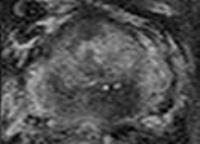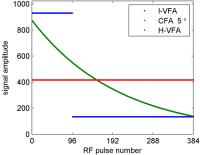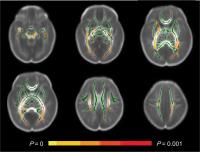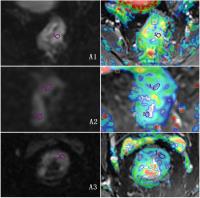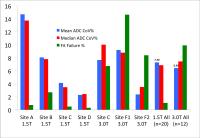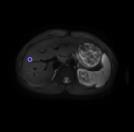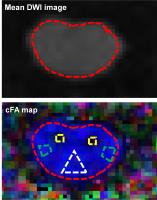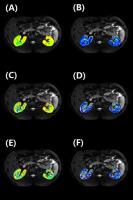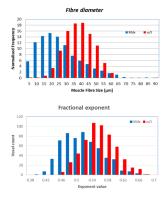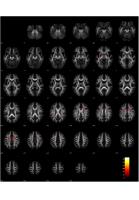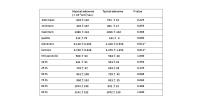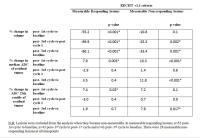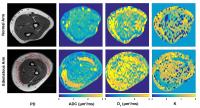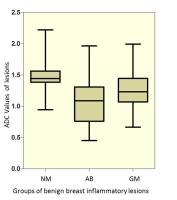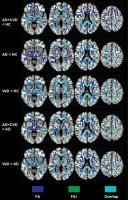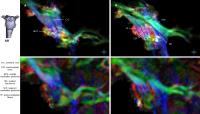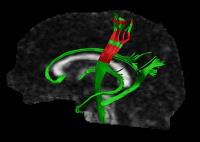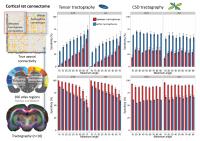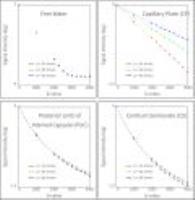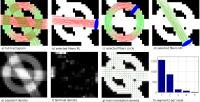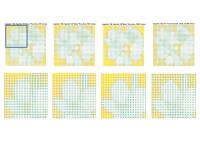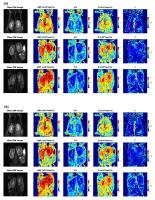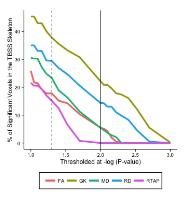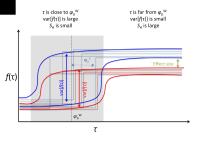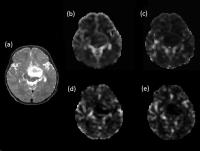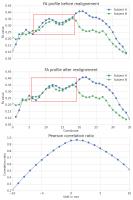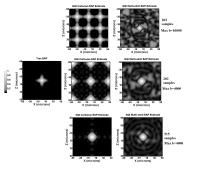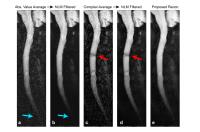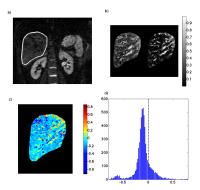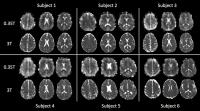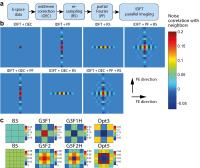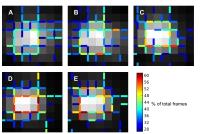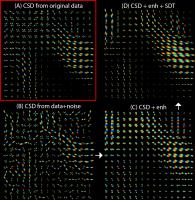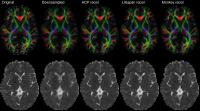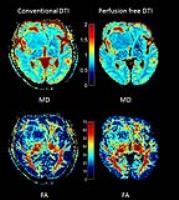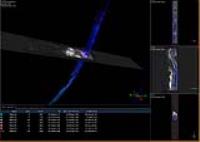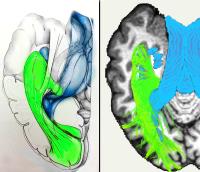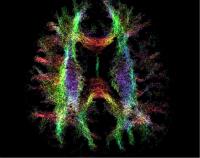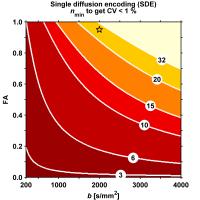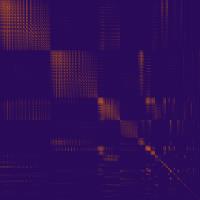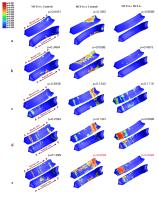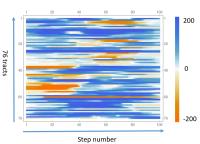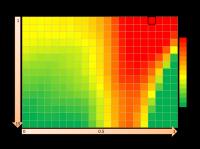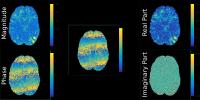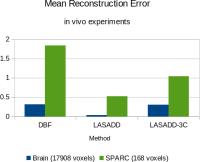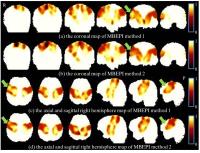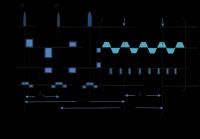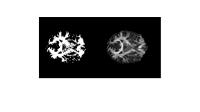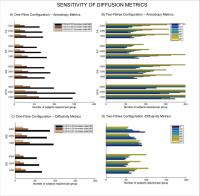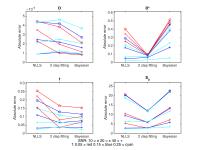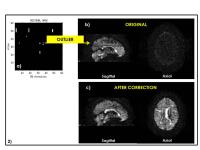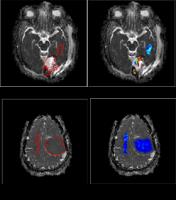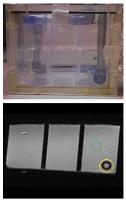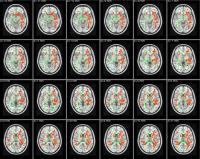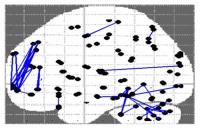|
1991.
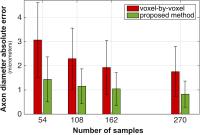 |
Reducing acquisition time for axon diameter mapping using global
optimization in the spatial-angular-microstructure space 
Anna Auria1, David Romascano1, Erick
J. Canales-Rodriguez2, Tim B. Dyrby3,
Daniel C. Alexander4, Jean-Philippe Thiran1,5,
Yves Wiaux6, and Alessandro Daducci1,5
1LTS5, École polytechnique fédérale de Lausanne (EPFL),
Lausanne, Switzerland, 2Centro
de Investigacion Biomedica en Red de Salud Mental (CIBERSAM),
Barcelona, Spain, 3Danish
Research Centre for Magnetic Resonance, Copenhagen
University Hospital Hvidovre, Hvidovre, Denmark, 4Department
of Computer Science and Centre for Medical Image Computing,
University College London, London, United Kingdom,5University
Hospital Center (CHUV) and University of Lausanne (UNIL),
Lausanne, Switzerland, 6Institute
of Sensors, Signals, and Systems, Heriot-Watt University,
Edimburgh, United Kingdom
State-of-the-art microstructure imaging methods usually fit
biophysical models to the diffusion MRI data on a
voxel-by-voxel basis using non-linear procedures that
require both long acquisitions and processing time. We
recently introduced AMICO, a framework to reformulate these
techniques as efficient linear problems and enable faster
reconstructions. Here, we propose an extension that enables
robust reconstructions from a reduced number of diffusion
measurements, thus leading to faster acquisitions, too. Our
novel formulation estimates simultaneously the
microstructure configuration in all voxels as a global
optimization problem, exploiting information from
neighboring voxels that cannot be taken into account with
existing techniques.
|
|
1992.
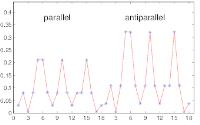 |
Characterization of Brain White Matter Tissue Structure with
Double-Diffusion-Encoded MRI 
Yasar Goedecke1 and
Jürgen Finsterbusch1
1Systems Neuroscience, University Medical Center
Hamburg-Eppendorf, Hamburg, Germany
Double-diffusion-encoding (DDE) or double-wave-vector (DWV)
experiments show a signal behavior that is specific for
restricted diffusion. Thus, these experiments could provide
more direct insight into tissue microstructure than
conventional experiments, especially when targeting axon
diameters. In this study, a previous DDE-based approach to
estimate axon diameters is extended (i) to be applicable
without prior knowledge of the fiber orientation, (ii) by
considering a more complex tissue composition including
spherical cells and an unrestricted compartment to model
glial cells and extracellular space, and (iii) using the
multiple correlation function framework that provides a more
accurate approximation of the MR signal.
|
|
1993.
 |
Numerical Simulations Comparing Pore Imaging Methods Based on
Diffusion-Weighted MR Imaging 
Yasar Goedecke1 and
Jürgen Finsterbusch1
1Systems Neuroscience, University Medical Center
Hamburg-Eppendorf, Hamburg, Germany
In a conventional diffusion-weighted MRI experiment, the
signal amplitude depends on the squared magnitude of the
Fourier transformation of the pore or cell geometry, i.e.
the underlying cell or pore geometry cannot be
reconstructed. Several approaches have been proposed that
determine the otherwise missing phase information and, thus,
can image the pore or cell geometry directly. Here, the
performance of these methods is compared with respect to
their applicability in practice, e.g. considering the impact
of the noise level, mixtures of pore sizes, orientations,
and shapes, and gradient pulse durations and diffusion times
achievable on standard MRI systems.
|
|
1994.
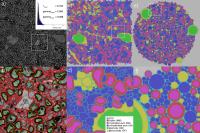 |
The effect of axon shape and myelination on diffusion signals in
a realistic Monte Carlo simulation environment 
Michiel Kleinnijenhuis1, Jeroen Mollink1,
Errin E Johnson2, Vitaly L Galinsky3,
Lawrence R Frank3, Saad Jbabdi1, and
Karla L Miller1
1Oxford Centre for Functional MRI of the Brain,
University of Oxford, Oxford, United Kingdom, 2Sir
William Dunn School of Pathology, University of Oxford,
Oxford, United Kingdom, 3Center
for Scientific Computation in Imaging, University of
California San Diego, La Jolla, CA, United States
The cylindrical models often used in Monte Carlo diffusion
simulations do not resemble the shape of axons very well. In
this work, a more realistic substrate derived from electron
microscopy data is used to investigate the influence of axon
shape and myelination on the diffusion signal. In the DifSim
simulation environment, diffusion signals from EM-derived
substrates are compared to those from cylindrical substrates
matched for volume fraction. Furthermore, the effect of
removing the impermeable myelin sheath from the substrate is
assessed.
|
|
1995.
 |
Modelling of diffusion in cultured epithelial cell spheroids 
Sisi Liang1, Madiha Yunus2, Eleftheria
Panagiotaki 3,
Byung Kim4, Timothy Stait-Gardner5,
Mikhail Zubkov5, Brian Hawkett4,
William Price5, Carl Power6, and Roger
Bourne2
1College of Engineering and Science, Victoria
University, Melbourne, Australia, 2Discipline
of Medical Radiation Sciences, Faculty of Health Sciences,
University of Sydney, Sydney, Australia, 3Center
for Medical Image Computing, University College London,
London, United Kingdom, 4Key
Centre For Polymer Colloids, University of Sydney, Sydney,
Australia, 5Nanoscale
Organisation and Dynamics Group, School of Science and
Health, Western Sydney University, Sydney, Australia, 6Mark
Wainright Analytical Centre, The university of New South
Wales, Sydney, Australia
Cultured epithelial cell spheroids demonstrate many of the
physiological properties of glandular epithelia and provide
an ideal experimental model for investigation of the
distinctive structural properties that may contribute to the
reported low water mobility in prostate, breast, and gut
epithelia. The structural connections are very similar to
those in intact tissue and thus they provide a more
realistic model of tissue than previously investigated
models based on pelleted yeast or erythrocyte cells. We
report an investigation of the correlation between known
cell sizes in a spheroid culture and restriction radius
estimated by a model of diffusion MRI signals.
|
|
1996.
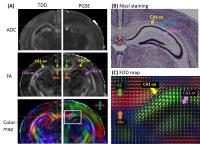 |
Imaging Three Dimensional Temporal Diffusion Spectrum Dispersion
Profiles in the Brain
Dan Wu1, Frances J Northington2, and
Jiangyang Zhang1,3
1Radiology, Johns Hopkins University School of
Medicine, BALTIMORE, MD, United States, 2Pediatrics,
Johns Hopkins University School of Medicine, BALTIMORE, MD,
United States, 3Radiology,
New York University School of Medicine, New Yourk, NY,
United States
The dispersion profile of the temporal diffusion spectrum
has been linked to key properties of tissue microstructures,
however, its directional variance has not been shown. In
this study, we extended the conventional one-dimensional
dispersion profile to three-dimensional profile, and
characterized its directionality with a tensor
representation. The temporal diffusion dispersion (TDD)
tensor demonstrated unique contrasts that reflected distinct
microstructural organization in the mouse brain, and the
high anisotropy from TDD tensors correlated with anisotropic
structural arrangements, e.g., in the crossing fiber
regions. The TDD contrasts are also sensitive to disrupted
microstructures in a neonatal mouse model of
hypoxic-ischemic injury.
|
|
1997.
 |
Spatiotemporal dynamics and patterns of cortical mean kurtosis
and fractional anisotropy in the preterm brains
Tina Jeon1, Aristeidis Sotiras2,
Minhui Ouyang1, Min Chen3, Lina Chalak4,
Christos Davatzikos2, and Hao Huang1,5
1Radiology Research, Children's Hospital of
Philadelphia, Philadelphia, PA, United States, 2Center
for Biomedical Image Computing and Analytics, University of
Pennsylvania, Philadelphia, PA, United States,3Department
of Mathematical Sciences, University of Texas at Dallas,
Richardson, TX, United States, 4Department
of Pediatrics, University of Texas Southwestern Medical
Center, Dallas, TX, United States, 5Perelman
School of Medicine, University of Pennsylvania,
Philadelphia, PA, United States
From early 3rd trimester to around birth, the cerebral
cortex undergoes dramatic microstructural changes including
dendritic arborization that disrupts the radial scaffold, a
well-organized columnar organization. Decrease of cortical
fractional anisotropy (FA) derived from DTI has been well
documented. In this study, we hypothesized that non-Gaussian
water diffusion properties (e.g. mean kurtosis or MK) from
diffusion kurtosis imaging (DKI) offers unique and
complementary information on cortical microstructural
changes during this period. The spatiotemporal changes and
patterns of cortical FA and MK from 32 to 41 postmenstrual
weeks were revealed, demonstrating unique cortical MK maps
and clustering patterns during preterm development.
|
|
1998.
 |
The influence of T2 relaxation in measuring the restricted
volume fraction in diffusion MRI
Silvia De Santis1, Yaniv Assaf2, and
Derek Jones1
1Cardiff University, CUBRIC, Cardiff, United
Kingdom, 2Department
of Neurobiology, Tel Aviv University, Tel Aviv, Israel
With the increasing popularity of multi-shell diffusion
techniques to measure axonal density and diameter, the
investigation of the exact origin of the contrast has become
a hot topic. Here, we investigate the impact of the echo
time in measuring the axonal density and show that the two
water compartments are characterised by a different
relaxation time T2, making the measures of the volume
strongly dependent on the echo time. This suggests caution
when comparing data acquired with different setups and
introduces a new way of measuring the differential T2
properties of intra- and extra-axonal water pools.
|
|
1999.
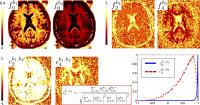 |
Diffusion MRI: Disentangling Micro- from Mesostructure and
Bayesian Parameter Evaluation
Marco Reisert1, Elias Kellner1, Bibek
Dhital1, Jürgen Hennig1, and Valerij
G. Kiselev1
1Department of Radiology, Medical Physics,
University Medical Center Freiburg, Freiburg, Germany
Diffusion-sensitized MRI probes the cellular structure of
the human brain, but the primary microstructural information
gets lost in averaging over higher-level, mesoscopic tissue
organization such as different orientations of neuronal
fibers. While such averaging is inevitable due to the
limited imaging resolution, we propose a method for
disentangling the microscopic cell properties from the
effects of mesoscopic structure. The proposed method finds
detectable parameters of a given microstructural model and
calculates them within seconds, which makes it suitable for
a broad range of applications.
|
|
2000.
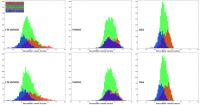 |
Intracellular volume fraction estimation in vivo in single and
crossing fibre regions 
Sjoerd B Vos1,2, Andrew Melbourne1,
John S Duncan2,3, and Sebastien Ourselin1
1Translational Imaging Group, University College
London, London, United Kingdom, 2MRI
Unit, Epilepsy Society, Chalfont St Peter, United Kingdom, 3Department
of Clinical and Experimental Epilepsy, UCL Institute of
Neurology, London, United Kingdom
Intracellular volume fraction (ICVF) is a valuable biomarker
of neurological disease. As one of two factors in g-ratio
estimates it could potentially reveal axonal function from
structural MRI measurements. Reliable ICVF estimation is
critical for both purposes. With various diffusion models in
existence for ICVF estimation, we compared the obtained ICVF
values and their reproducibility in voxels with 1, 2, and 3
fibre populations between three diffusion modelling
approaches. Absolute ICVF values vary significantly between
models as well as between voxels with different fibre
complexity.
|
|
2001.
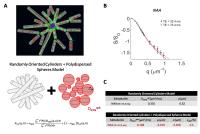 |
Modeling diffusion of intracellular metabolites in the mouse
brain up to very high b: diffusion in long fibers (almost)
accounts for non-monoexponential attenuation
Marco Palombo1,2, Clémence Ligneul1,2,
and Julien Valette1,2
1CEA/DSV/I2BM/MIRCen, Fontenay-aux-Roses, France, 2CNRS
Université Paris-Saclay UMR 9199, Fontenay-aux-Roses, France
We investigate how metabolite diffusion measured up to very
high b (60 ms/µm2) at relatively short diffusion
time (63.2 ms) in the mouse brain can be explained in terms
of simple geometries. We model cell fibers as isotropically
oriented cylinders of infinite length, and show this can
account very well for measured non-monoexponential
attenuation. The only exception is NAA, for which the model
extracts fiber diameter equal to 0. We show that is
theoretically and experimentally compatible with a small
fraction of the NAA pool being confined in highly restricted
compartments (with short T2), e.g. a
mitochondrial pool.
|
|
2002.
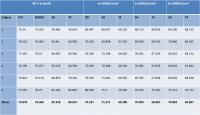 |
Evaluation of Diffusion MRI Based Feature Sets for the
Classification of Primary Motor and Somatosensory Cortical
Areas.
Tara Ganepola1,2, Jiaying Zhang2, Hui
Zhang2, Martin I Sereno3, and Daniel C
Alexander2
1Department of Cognitive, Perceptual and Brain
Sciences, University College London, London, United Kingdom, 2Centre
for Medical Image Computing, University College London,
London, United Kingdom, 3Birkbeck-UCL
Centre for Neuroimaging, University College London, London,
United Kingdom
In the following work several diffusion based feature
vectors (DTI, NODDI, spherical harmonic (SH) invariants and
fourth order tensor invariants (T4)) are compared in order
to validate their usability in grey matter investigations.
It was found that using multi-shell data and non-biophysical
models such as SH and T4 achieves the highest classification
accuracy between the primary motor and somatosensory
cortical areas, and thus is likely to characterise grey
matter tissues domains more effectively.
|
|
2003.
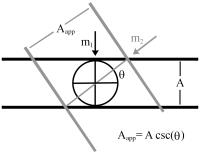 |
Inferring axon diameter from the apparent cylindrical geocentric
diameter in the longitudinal plane
Farshid Sepehrband1 and
Kristi A Clark1
1Laboratory of Neuro Imaging, USC Mark and Mary
Stevens Neuroimaging and Informatics Institute, Keck School
of Medicine of USC, Los Angeles, CA, United States
Recent diffusion-weighted imaging techniques have enabled
the inference of axon diameter, a valuable neuroanatomical
measure1,2. Current techniques fit a cylindrical
model of axons to the acquired signal, primarily in the
transverse direction. Despite many improvements, sensitivity
to small axons is difficult to achieve, primarily due to the
scanner’s physical limitations. Even with a strong gradient
strength system such as the connectome scanner and high SNR,
the minimum resolvable axon diameters are greater than 2μm,
which accounts for only a small proportion of axons in the
human brain. Here we utilize Neuman’s cylindrical model3,
and generalize it to the geocentric direction in the
longitudinal plane of axons (Figure 1) to decrease the
minimum axon diameter resolvable with a given scanner.
|
|
2004.
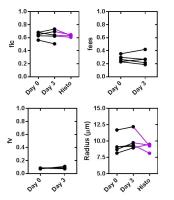 |
In vivo characterisation of mouse brain glioma using VERDICT MRI
and validation with histology
Tom A Roberts1, Giulia Agliardi1,
Andrada Ianus2, Ben Jordan1, James O
Breen-Norris1, Rajiv Ramasawmy1,
Angela D'Esposito1, Valerie Taylor1,
Bernard Siow1, Eleftheria Panagiotaki2,
Daniel C Alexander2, Mark F Lythgoe1,
and Simon Walker-Samuel1
1Centre for Advanced Biomedical Imaging, London,
United Kingdom, 2Centre
for Medical Image Computing, London, United Kingdom
Vascular Extracellular and Restricted Diffusion for
Cytometry in Tumours (VERDICT) is a diffusion MRI technique
which uses a 3-compartment model to characterise the
vascular (V), extracellular-extravascular (EES) and
intracellular (IC) compartments in tumours. VERDICT allows
for quantitation of tumour morphology including vascular
fraction (fv), intracellular fraction (fic) and cellular
radius, hence providing a non-invasive ‘biopsy’ that can be
performed longitudinally. Previously, VERDICT has been
applied to subcutaneous mouse tumours1 and
human prostate cancer2. For the first time, we
apply VERDICT in a mouse model of glioma, examine it in the
context of other multi-compartment models and optimise it
based on comparison with histological analysis.
|
|
2005.
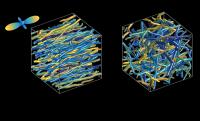 |
Generative statistical models of white matter microstructure for
MRI simulations in virtual tissue blocks
Leandro Beltrachini1 and
Alejandro Frangi1
1The University of Sheffield, Sheffield, United
Kingdom
In silico studies of diffusion MRI are becoming a standard
tool for testing the sensitivity of the technique to changes
in white matter (WM) structures. To perform such
simulations, realistic models of brain tissue microstructure
are needed. However, most of the computational results are
obtained considering straight and parallel cylinders models,
which are known to be too simplistic for representing
real-scenario situations. We present a statistical-driven
approach for obtaining random models of WM tissue samples
based on histomorphometric data available in the literature.
We show the versatility of the method for characterising WM
voxels representing bundles and disordered structures.
|
|
2006.
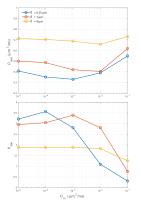 |
Does Myelin Water Influence DWI? 
Kevin D Harkins1 and
Mark D Does1,2,3,4
1Institute of Image Science, Vanderbilt
University, Nashville, TN, United States, 2Biomedical
Engineering, Vanderbilt University, Nashville, TN, United
States, 3Radiology
and Radiological Sciences, Vanderbilt University, Nashville,
TN, United States, 4Electrical
Engineering, Vanderbilt University, Nashville, TN, United
States
The presence and movement of myelin water is often neglected
from models of DWI signal. This study presents a Monte Carlo
simulation illustrating that myelin water diffusion can have
a subtle but important impact on measured Dapp and Kapp values,
and that incorporating myelin water diffusion can influence
myelin-content dependent changes in Dapp and Kapp.
|
|
2007.
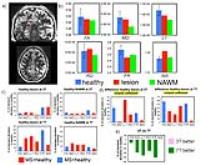 |
Characterizing microstructural changes in Multiple Sclerosis
lesions using advanced diffusion MRI at 3T and 7T
Silvia De Santis1,2, Matteo Bastiani2,
Henk Jansma2, Amgad Droby3, Pierre
Kolber3, Eberhard Pracht4, Tony
Stoecker4, Frauke Zipp3, and Alard
Roebroeck2
1Cardiff University, CUBRIC, Cardiff, United
Kingdom, 2Dept.
of Cognitive Neuroscience, Faculty of Psychology &
Neuroscience, Maastricht University, Maastricht,
Netherlands, 3Department
of Neurology and Neuromaging Center, University Medical
Center of the Johannes Gutenberg University, Mainz, Germany, 4German
Center for Neurodegenerative diseases, Bonn, Germany
Aim of this work was to test the ability of conventional
(i.e., DTI) and advanced (i.e., CHARMED, stretched
exponential) diffusion methods to differentiate between
Multiple Sclerosis lesions, normal appearing white matter
and healthy controls, at both 3T and 7T. Advanced dMRI at 7T
gives the best discriminating power between MS lesions and
healthy tissue across WM; DTI is appropriate in areas of low
fiber dispersion like the corpus callosum.
|
|
2008.
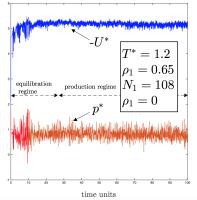 |
Exploring Structural, Diffusive and Thermodynamic Properties of
Model Systems with Molecular Dynamics Simulations
Jonathan Phillips1
1Institute of Life Science, College of Medicine,
Swansea University, Swansea, United Kingdom
This work aims at introducing methods of molecular dynamics
(MD) simulation into diffusion MRI modelling. MD allows the
study of transport properties (e.g. diffusion), structural
properties (e.g. radial distribution functions) and
thermodynamic properties (e.g. pressure). Access to all of
these properties allows investigation into the links between
them. We present the first steps into studying all of these
properties (including the diffusion coefficient and
kurtosis) in model systems for comparison with MRI data. The
system is a binary mixture which includes a diffusing
species (the solvent e.g. water) and a larger
spatially-fixed species (modelling cellular-sized colloid
particles).
|
|
2009.
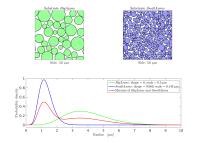 |
Axon diameter distribution influences diffusion-derived axonal
density estimation in the human spinal cord: in silico and in
vivo evidence 
Francesco Grussu1, Torben Schneider1,2,
Ferran Prados1,3, Carmen Tur1,
Sébastien Ourselin3, Hui Zhang4,
Daniel C. Alexander4, and Claudia Angela Michela
Gandini Wheeler-Kingshott1,5
1NMR Research Unit, Queen Square MS Centre,
Department of Neuroinflammation, UCL Institute of Neurology,
University College London, London, United Kingdom, 2Philips
Healthcare, Guildford, Surrey, England, United Kingdom, 3Translational
Imaging Group, Department of Medical Physics and Biomedical
Engineering, University College London, London, United
Kingdom, 4Department
of Computer Science and Centre for Medical Image Computing,
University College London, London, United Kingdom, 5Brain
Connectivity Center, C. Mondino National Neurological
Institute, Pavia, Italy
Diffusion MRI-derived neurite density is a potential
biomarker in neurological conditions. In the brain, neurites
are commonly modelled as sticks for
sufficiently long diffusion times and gradient durations.
However, in the spinal cord, large axons are present and
typical diffusion times (20-30 ms) may not be sufficiently
long to support this model. We investigate via simulations
and in vivo whether
neurite density estimation is affected by the diffusion time
in the spinal cord. Short diffusion times lead to bias,
while long diffusion times improve accuracy but reduce
precision. Therefore, a trade-off accuracy-precision needs
to be evaluated depending on the application.
|
|
2010.
 |
A quantitative measurement of the cell membrane water
permeability of expression-controlled AQP4 cells with diffusion
weighted MRI
Takayuki Obata1, Jeff Kershaw2,
Yasuhiko Tachibana1, Youichiro Abe3,
Sayaka Shibata2, Yoko Ikoma2, Hiroshi
Kawaguchi4, Ichio Aoki2, and Masato
Yasui3
1Applied MRI Research, National Institute of
Radiological Sciences, Chiba, Japan, 2Molecular
Imaging Center, National Institute of Radiological Sciences,
Chiba, Japan, 3Department
of Pharmacology, Keio University, Tokyo, Japan, 4Human
Informatics Research Institute, National Institute of
Advanced Industrial Science and Technology (AIST), Tsukuba,
Japan
We performed multi-b and multi-diffusion-time DWI on
aquaporin-4-expressing and non-expressing cells, and
demonstrated a clear difference between the signals from the
two cell types. The data was interpreted with a
two-compartment model including inter-compartmental
exchange. It was also assumed that restricted diffusion of
water molecules inside the cells leads to the intracellular
diffusion coefficient being inversely proportional to the
diffusion-time. Estimates of the water-exchange times with
this model were comparable with those measured using an
independent optical imaging technique, which suggests that
this method might be used to characterize cell-membrane
water permeability. As the technique can be applied in
routine clinical examination, it has the potential to
improve clinical diagnosis.
|
|
2011.
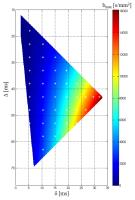 |
Acquisition Protocol Optimization for Axon Diameter Mapping at
High-Performance Gradient Systems – A Simulation Study
Jonathan I Sperl1, Ek Tsoon Tan2,
Miguel Molina Romero1,3, Marion I Menzel1,
Chris J Hardy2, Luca Marinelli2, and
Thomas K.F. Foo2
1GE Global Research, GARCHING, Germany, 2GE
Global Research, NISKAYUNA, NY, United States, 3Institute
of Medical Engineering, Technische Universität München,
GARCHING, Germany
The measurement of axonal diameter by diffusion MRI
techniques has assumed major interest in the research
community. While most work has focused on developing and
comparing various multi-compartment models, only minor
efforts have been undertaken to optimize corresponding
acquisition protocols. In this work we perform simulations
using a rather simple two-compartment model, but study the
effect of various choices of acquisition parameters on the
precision and the bias of the fitted parameters. More
precisely, we analyze potential sampling strategies in the
2D design space spanned by the two timing parameters (Δ, δ)
of the diffusion encoding.
|
|
2012.
 |
NODDI and AxCaliber diffusion-weighted imaging at ultrahigh
field for microstructural imaging of the mouse spinal cord
Ahmad Joman Alghamdi1,2, Hari K Ramachandran3,
Ian M Brereton1, and Nyoman D Kurniawan1
1Centre for Advanced Imaging, The University of
Queensland, Brisbane, Australia, 2College
of Health Sciences, Taif University, Taif, Saudi Arabia, 3Computer
Science and Engineering, SRM University, Kattankulathur,
India
DTI has been used to measure changes in spinal cord WM, but
lacks the specificity in measuring changes in GM and axonal
diameter. This study aims to apply NODDI and AxCaliber
techniques to measure characteristics of the lumbar spine in
C57BL/6 mice, in-vivo at
9.4T and ex-vivo at
16.4T. The GM orientation distribution index is 3 times that
of the WM, and the correlation of ODI to FA is r=–0.9, P<<0.01
for GM and r=–0.56, P<<0.01
for WM. AxCaliber analysis determined WM axon diameter
populations with an average of 1.55±0.15mm (in-vivo);
and 1.37±0.20 mm (ex-vivo).
|
|
2013.
 |
White matter alterations in young adults born extremely preterm:
a microstructural point of view.
Zach Eaton-Rosen1, Andrew Melbourne1,
Joanne Beckmann2, Eliza Orasanu1,
Nicola Stevens3, David Atkinson4, Neil
Marlow2, and Sebastien Ourselin1
1TIG, UCL, London, United Kingdom, 2UCL
EGA Institute for Women's Health, London, United Kingdom, 3UCLH,
London, United Kingdom, 4CMIC,
UCL, London, United Kingdom
We used NODDI and DTI in order to investigate the
differences in white matter between young adults born at
term, and those born at fewer than 26 weeks completed
gestation, using TBSS. The differences in FA were closely
mirrored by the differences in orientation dispersion index
(ODI) while the intra-axonal volume fraction (Vi) did not
show significant differences in the same regions. This
suggests that the ODI may be more sensitive to indicators of
being born preterm than Vi in the white matter.
|
|
2014.
 |
Statistical assessment of a model combining IVIM and T2 decay
for multi-b-value, multi-echo-time DW-MRI in abdominal organs 
Matthew R Orton1, Neil P Jerome1,
Thorsten Feiweier2, Dow-Mu Koh3,
Martin O Leach4, and David J Collins4
1Radiotherapy and Imaging, Institute of Cancer
Research, London, United Kingdom, 2Siemens
Healthcare, Erlangen, Germany, 3Department
of Radiology, Royal Marsden NHS Foundation Trust, London,
United Kingdom, 4CRUK
Cancer Imaging Centre, Division of Radiotherapy and Imaging,
Institute of Cancer Research, London, United Kingdom
The IVIM model is essentially a two-compartment model, and
it has previously been noted that the T2 relaxation times in
each compartment may not be equal. This work uses the
Akaike Information Criterion to compare two combined IVIM-T2
models using data acquired in various abdominal organs with
all combinations of five echo-times and six b-values. The
first model has the same T2 in each compartment, the second
has different T2s, and we show that the second model has
greater statistical support in the liver (but not spleen or
kidney), implying that both T2 values can be measured in
this organ.
|
|
2015.
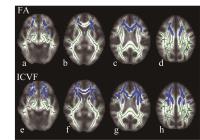 |
Extensive White Matter Damage in Neuromyelitis Optica Assessed
by Neurite Orientation Dispersion and Density Imaging: A
Tact-Based Spatial Statistics study
Tomohiro Takamura1, Shou Murata2, Koji
Kamagata3, Kouhei Tsuruta2, Masaaki
Hori3, Michimasa Suzuki3, and Shigeki
Aoki3
1University of Yamanashi, Yamanashi, Japan, 2Tokyo
Metropolitan University, Tokyo, Japan, 3Juntendo
University, Tokyo, Japan
Recently, patients with neuromyelitis optica (NMO) have
shown extensive white matter damage, which could be related
not only to Wallerian degeneration resulting from lesions of
spinal cord or optic tracts but also to demyelination by
using diffusion-tensor (DT) MRI imaging. This study aimed to
evaluate the expansion of white matter damage in NMO
assessed using neurite orientation dispersion and density
imaging (NODDI), as well as its relationship with disease
severity by applying Tact Based Spatial Statistics (TBSS).
|
|
2016.
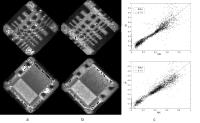 |
Comparison of fast and conventional diffusion kurtosis imaging
in an anisotropic synthetic phantom 
Ganna Blazhenets1,2, Farida Grinberg1,3,
Ezequiel Farrher1, Xiang Gao1, Mikheil
Kelenjeridze4, Tamo Xechiashvili4, and
N. Jon Shah1,3
1Institute of Neuroscience and Medicine - 4,
Forschungszentrum Juelich, Juelich, Germany, 2Institute
of Nuclear Physics, University of Cologne, Cologne, Germany, 3Department
of Neurology, Faculty of Medicine, JARA, RWTH Aachen
University, Aachen, Germany, 4Department
of Physics, Georgian Technical University, Tbilisi, Georgia
We compare the sensitivity and applicability of two methods
for the estimation of mean kurtosis in a multi-sectional,
anisotropic diffusion phantom using conventional diffusion
kurtosis imaging and a fast protocol for rapid mean kurtosis
metric estimation suggested by Hansen et al. (2013). Both
methods provide similar image quality and it can be
concluded that fast estimation of mean kurtosis is a useful
tool that can be used as a fast method for clinical
applications. An interesting finding of this work is a
stronger dependence of fast computed kurtosis metrics on the
orientation of fibres with respect to the static magnetic
field than of the conventional method.
|
|
2017.
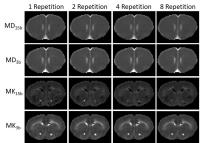 |
Evaluating mean diffusivity and mean kurtosis derived from
different diffusion-encoding schemes and signal-to-noise ratio
Chia-Wen Chiang1, Shih-Yen Lin1,2,
Yi-Ping Chao3, Yeun-Chung Chang4,5,
Teh-Chen Wang6, and Li-Wei Kuo1
1Institute of Biomedical Engineering and
Nanomedicine, National Health Research Institutes, Miaoli,
Taiwan, 2Department
of Computer Science, National Chiao Tung University,
Hsinchu, Taiwan, 3Gradulate
Institute of Medical Mechatronics, Chang Gang University,
Taoyuan, Taiwan, 4Department
of Medical Imaging, National Taiwan University Hospital,
Taipei, Taiwan, 5Department
of Radiology, National Taiwan University College of
Medicine, Taipei, Taiwan, 6Department
of Radiology, Taipei City Hospital Yang-Ming Branch, Taipei,
Taiwan
Diffusion kurtosis imaging (DKI), evaluating the
non-Gaussianity of water diffusion, has been demonstrated to
be sensitive biomarker in many neurological diseases.
However, number of repetition is one of the factors, but
people is trying less to investigate it. In this study,
normal rats were performed using two different diffusion
scheme protocols (15 b-values with six diffusion directions
vs. 3 b-values with thirty directions) and with different
repetitions. Our results suggesting the protocol with one
repetition provides good image quality for DKI analysis in
this case.
|
|
2018.
 |
Maximum b-value dependence of Diffusion kurtosis imaging
sensitivity in detecting white matter microstructure
Miao Sha1, Yuanyuan Chen1, Xin Zhao1,
Man Sun2, Weiwei Wang1, Hongyan Ni2,
and Dong Ming1
1Tianjin University, Tianjin, China, People's
Republic of, 2Tianjin
First Center Hospital, Tianjin, China, People's Republic of
Diffusion kurtosis imaging is a powerful technique to
measure the non-gaussion diffusion as well as the
complicated microstructure. In this paper, we conducted a
comparison between different acquisitions with different
maximum b-value on normal volunteers. We found that the
outcome of diffusion kurtosis imaging was influenced by the
maximum b-value in the acquisition. And this influence was
highly associated with the microstructure, including both
radial profile and angular profile in the structure
reconstruction, which indicated the mechanism of
non-gaussion under high b-value.
|
|
2019.
 |
Determination of Microvascular Parameters from
Diffusion-Weighted Images
Robert J Loughnan1,2, Damien McHugh1,3,
Hamied A Haroon1, Douglas Garratt2,
Rishma Vidyasagar1,4, Hojjatollah Azadbakht1,
Penny H Cristinacce1, Geoff JM Parker1,5,
and Laura M Parkes1
1Centre for Imaging Sciences, Faculty of Medical
and Human Sciences, The University of Manchester,
Manchester, United Kingdom, 2School
of Physics and Astronomy, The University of Manchester,
Manchester, United Kingdom, 3CRUK
& EPSRC Cancer Imaging Centre in Cambridge & Manchester,
Manchester, United Kingdom, 4Melbourne
Brain Centre, The Florey Institute of Neuroscience and
Mental Health, Melbourne, Australia, 5Bioxydyn
Limited, Manchester, United Kingdom
Diffusion imaging has been used to probe microstructure and
to investigate perfusion via the IVIM model. However, the
contribution of microvasculature structure to the diffusion
signal has largely been overlooked. Presented here is a
novel method for imaging blood velocity and capillary
segment length using diffusion-weighted images. We apply a
model for extracting perfusion parameters from
diffusion-weighted images from 23 people with a range of
diffusion times (?=18, 35 and 55ms) and b-values (0-100s/mm2).
Mean blood velocity was significantly slower (P<0.005) in
white matter (0.92±0.03mm/s) compared to grey matter
(0.95±0.04mm/s). Mean vessel segment length was
significantly shorter (P<0.0001) in white matter
(7.97±0.13µm) than in grey matter (10.35±0.20µm).
|
|
2020.
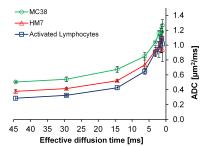 |
Detection of lymphocytes fractions using temporal diffusion
spectroscopy 
Johannes Riegler1, Maj Hedehus1, and
Richard A. D. Carano1
1Biomedical Imaging, Genentech, South San
Francisco, CA, United States
Inflammation and T-cell infiltration are important
prognostic biomarkers for cancer immunotherapies.1 Current
clinical practice relies on histological assessment of
tissue biopsies which is invasive and prone to sampling
errors. Temporal diffusion spectroscopy, particularly with
short effective diffusion times can estimate cell sizes.2,3 Lymphocytes
have small diameters compared to typical tumor cells. We
therefore tested the ability of temporal diffusion
spectroscopy to differentiate between pellets of tumor cells
mixed with a varying amount of activated lymphocytes. We
observed clearly separable diffusion characteristics for
samples containing > 20% lymphocytes indicating that this
approach may have potential to quantify inflammation in
highly inflamed tissues.
|
|
2021.
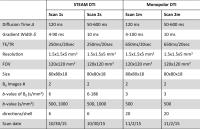 |
Estimation of Fiber Packing Correlation Length by Varying
Diffusion Gradient Pulse Duration 
Hong-Hsi Lee1, Gregory Lemberskiy1,
Els Fieremans1, and Dmitry S. Novikov1
1New York University, Center for Biomedical
Imaging, New York, NY, United States
Finite pulse duration $$$\delta$$$ of diffusion gradient has
typically been a source of bias for quantifying
microstructure. Here, we suggest to use the diffusivity
dependence on $$$\delta$$$ to reveal the correlation length
of the fiber packing, an essential μm–level characteristic
of microstructure, thereby turning the finite pulse duration
to our advantage. We validate our method in a fiber phantom
that mimics an axonal packing geometry, and the estimated
correlation length matches the fiber radius. Future work
will focus on the evaluation of its potential as biomarkers
for in vivo brain scans, such as axonal density and outer
axonal diameters.
|
|
2022.
 |
Detection of Early Emphysema by Quantifying Lung Terminal
Airways with Hyperpolarized 129Xe Diffusion MRI
Weiwei Ruan1, Jianping Zhong1, Ke Wang2,
Yeqing Han1, and Xin Zhou1
1Wuhan Institute of Physical and
Mathematics,Chinese Academy of Sciences, Wuhan, China,
People's Republic of, 2Department
of MRI, zhongnan hospital of wuhan university, Wuhan, China,
People's Republic of
To detect the early emphysema, hyperpolarized xenon
diffusion MRI with multi-b values was used to quantify the
lung terminal airways in five initial stages of
emphysematous rats and five control rats. The DL(longitudinal
diffusion coefficient), r, h, LM and
S/V in the emphysematous group showed significant
differences compared to those in the control group (P<0.05)
and also exhibited a strong linear correlation (|r|>0.8) to
Lm from histology for all the rats. The results showed
multi-b diffusion MRI of hyperpolarized xenon has potential
for the diagnosis of emphysema at the early stage.
|
|
2023.
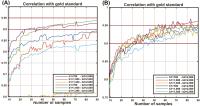 |
A Time-Efficient Acquisition Protocol For Multi-Purpose
Diffusion-Weighted Microstructural Imaging At 7T
Farshid Sepehrband1,2, Kieran O’Brien1,3,
and Markus Barth1
1Centre for Advanced Imaging, University of
Queensland, Brisbane, Australia, 2Laboratory
of Neuro Imaging, USC Mark and Mary Stevens Neuroimaging and
Informatics Institute, Keck School of Medicine of USC, Los
Angeles, CA, United States, 3Siemens
Healthcare Pty Ltd, Brisbane, Australia
Several diffusion-weighted MRI techniques for modeling
tissue microstructure have been developed and validated
during the past two decades. While offering various
neuroanatomical inferences, these techniques differ in their
proposed optimal acquisition design, which impede clinicians
and researchers to benefit from all potential inference
methods, particularly when limited time is available. We
examined the performance of the most common diffusion models
with respect to acquisition parameters at 7T when limiting
the acquisition time to about 10 minutes. The most balanced
compromise among all combinations in terms of the robustness
of the estimates was a two-shell scheme with b-values of
1,000 and 2,500 s/mm2 with
75 diffusion-encoding gradients, 25 and 50 samples for low
and high b-values, respectively.
|
|
2024.
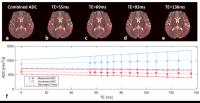 |
Extraction of Tissue-Specific ADC Based on Multi-Exponential T2
Analysis 
Qiqi Tong1, Mu Lin1, Hongjian He1,
Xu Yan2, Thorsten Feiweier3, Hui Liu2,
and Jianhui Zhong1
1Center for Brain Imaging Science and Technology,
Department of Biomedical Engineering, Zhejiang University,
Hangzhou, China, People's Republic of, 2MR
Collaboration NE Asia, Siemens Healthcare, Shanghai, China,
People's Republic of, 3Siemens
Healthcare, Erlangen, Germany
Multi-component diffusion models with each component of its
own T2 value
have been studied previously. When the diffusion signal is
decomposed into three compartments (short, intermediate and
long T2), the respective ADC values can be
obtained. Our results from simulations and in vivo
measurements show that the model successfully separates
signal from different tissue types, allows extraction of
tissue-specific ADC, and results are mostly free of partial
volume problem. Moreover, an ADC without T2 effect
can also be generated by combining the ADCs of all
components.
|
|
2025.
 |
Single Compartment model estimates of acinar duct measurements
from inhaled noble gas MRI: Proof of Concept in alpha-1
antitrypsin deficiency emphysema
Eric Lessard1, Alexei Ouriadov1, David
G McCormack2, and Grace Parraga1
1Robarts Research Institute, The University of
Western Ontario, London, ON, Canada, 2Department
of Medicine, The University of Western Ontario, London, ON,
Canada
Diffusion-weighted MRI provides a way to non-invasively
estimate in vivo morphometry measurements of the alveolar
ducts. Current modelling approaches may not be appropriate
for cases of severe tissue destruction where the geometry of
the acinar ducts may not be uniform, nor cylindrical.
Therefore, in this proof-of-concept evaluation, we used a
single-compartment model and multiple b-value
diffusion-weighted noble gas pulmonary MRI to generate
estimates of acinar duct surface-to-volume ratio and
mean-linear-intercept. In cases of very severe emphysema
that accompany alpha-one antitrypsin deficiency, this
approach well-approximated the severity of lung disease,
while the cylindrical model did not.
|
|
2026.
 |
Use envelope bounding to improve the stability of intravoxel
incoherent motion modeling
Cheng-Ping Chien1, Feng Mao Chiu2, and
Queenie Chan3
1Institute of Biomedical Electronics and
Bioinformatics, National Taiwan University, Taipei, Taiwan, 2Philips
Healthcare, Taipei, Taiwan, 3Philips
Healthcare, Hong Kong, China, People's Republic of
Intravoxel incoherent motion (IVIM) model is useful tool to
observe the microcirculatory perfusion, but its stability
still needs to be improved. We propose the envelope bounding
technique to reduce the fluctuated signal at low b-value,
and use this new signal profile to fit IVIM model. This
improvement gives a more stable outcome with fast diffusion
(D*) and perfusion fraction (PF).
|
|
2027.
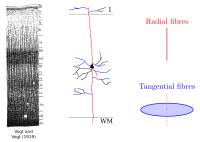 |
Modelling radial and tangential fibres in the neocortex
Luke J. Edwards1, Siawoosh Mohammadi1,2,
Pierre-Louis Bazin3, Michiel Kleinnijenhuis4,
Kerrin J. Pine1, Anne-Marie van Cappellen van
Walsum5, Hui Zhang6, and Nikolaus
Weiskopf1,3
1Wellcome Trust Centre for Neuroimaging, UCL
Institute of Neurology, UCL, London, United Kingdom, 2Institut
für Systemische Neurowissenschaften, Universitätsklinikum
Hamburg-Eppendorf, Hamburg, Germany,3Department
of Neurophysics, Max Planck Institute for Human Cognitive
and Brain Sciences, Leipzig, Germany, 4FMRIB
Centre, University of Oxford, Oxford, United Kingdom, 5Department
of Anatomy, Donders Institute for Brain, Cognition and
Behaviour, Radboud University, Nijmegen, Netherlands, 6Centre
for Medical Image Computing, Department of Computer Science,
UCL, London, United Kingdom
The structure of neocortical grey matter is complex due to
the crossing intracortical neuronal connections involved in
cortical processing. Herein we present a two-step method to
capture radial and tangential fibre structure of neocortex
from diffusion data: first the radial cortical orientation
is extracted voxelwise using surface-based methods, and then
a three-compartment diffusion model extracts radial and
tangential fibre volume fractions. We demonstrate in a post
mortem sample of human V1 tissue that this method captures
structure known from histology and comparable diffusion
models, implying potential future use as a probe of
intracortical neuronal connectivity.
|
|
2028.
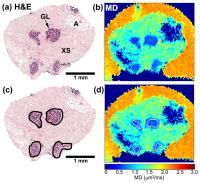 |
Correlation of diffusion-weighted MRI with cellularity in
glandular breast tissue 
Narina Norddin1,2, Nyoman Kurniawan3,
Gary Cowin3, Carl Power4, Geoffrey
Watson5, Esther Myint6, Laurence Gluch7,
and Roger Bourne1
1University of Sydney, Sydney, Australia, 2International
Islamic University Malaysia, Pahang, Malaysia, 3University
of Queensland, Brisbane, Australia, 4University
of New South Wales, Sydney, Australia, 5Royal
Prince Alfred Hospital, Sydney, Australia, 6Douglass
Hanly Moir Pathology, Sydney, Australia, 7The
Strathfield Breast Centre, Sydney, Australia
Although diffusivity (ADC) changes in tissue are commonly
attributed to variations in ‘cellularity’, direct evidence
from breast tissue studies is limited and inconsistent. Here
we report a diffusion microimaging and histology
investigation of the correlation of mean diffusivity (MD)
with cellularity in the glandular component of breast
tissue. Diffusion microimaging was performed at 16.4T on
fixed normal and cancer tissue samples and matched with post
MRI histology. There was a moderate correlation between MD
and nuclear count, but only a weak correlation between MD
and nuclear area.
|
|
2029.
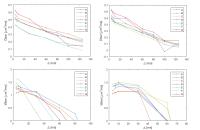 |
Time dependence of diffusion and kurtosis parameters in the rat
spinal cord 
Sune Nørhøj Jespersen1,2, Brian Hansen1,
Daniel Nunes3, and Noam Shemesh3
1CFIN, Aarhus University, Aarhus, Denmark, 2Dep.
Physics and Astronomy, Aarhus University, Aarhus, Denmark, 3Champalimaud
Neuroscience Programme, Champalimaud Centre for the Unknown,
Lisbon, Portugal
Non-vanishing diffusion kurtosis and time-dependent
diffusion are both hallmarks of nongaussian diffusion in
biological tissues. Here we combine measurements of
time-dependent DTI parameters and time dependence of mean
kurtosis using fast kurtosis imaging in rat spinal cord. We
observe substantial time dependence of all parameters in
both white and gray matter.
|
|
2030.
 |
Distinguishing between different microstructural changes using
optimised diffusion-weighted acquisitions 
Damien J. McHugh1,2 and
Geoff J.M. Parker1,2,3
1Centre for Imaging Sciences, The University of
Manchester, Manchester, United Kingdom, 2CRUK
& EPSRC Cancer Imaging Centre in Cambridge & Manchester,
United Kingdom, 3Bioxydyn
Ltd., Manchester, United Kingdom
This work investigates the use of optimised
diffusion-weighted acquisitions for distinguishing between
different microstructural changes relevant to characterising
tumour tissue. Optimised protocols are found for a
'baseline' microstructure, and for two distinct changes
which would lead to an ADC increase: (1) volume fraction
decrease with cell size constant (therefore a decrease in
cell density), (2) cell size decrease and coupled volume
fraction decrease (therefore a constant cell density). Model
fitting simulations are performed with optimised and
non-optimised protocols, demonstrating that the improved
precision achieved with optimised protocols may be
beneficial in terms of distinguishing between these
microstructural changes.
|
|
2031.
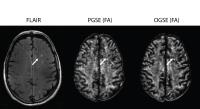 |
Oscillating Gradient Spin Echo Diffusion Tensor MRI of the Brain
in Multiple Sclerosis Patients
Christian Beaulieu1, Corey Baron1,
Penny Smyth2, Roxane Billey2, Leah
White2, Fabrizio Giuliani1, Derek
Emery3, and Robert Stobbe1
1Biomedical Engineering, University of Alberta,
Edmonton, AB, Canada, 2Neurology,
University of Alberta, Edmonton, AB, Canada, 3Radiology,
University of Alberta, Edmonton, AB, Canada
In diffusion tensor imaging, oscillating gradient spin echo
(OGSE) gradient waveforms enable much shorter diffusion
times (4 ms) than the typical pulsed gradient spin echo
(PGSE, 40 ms) and OGSE was applied here for the first time
in multiple sclerosis patients. A different dependence on
diffusion time would suggest a change in micro-structural
scale within the MS lesions. Compared to normal appearing
white matter (NAWM), FLAIR-visible lesions showed reductions
of fractional anisotropy (FA) on both PGSE and OGSE. The
proportional FA decrease between NAWM and lesions was
similar for OGSE and PGSE.
|
|
2032.
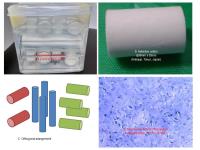 |
Longitudinal stability of astriction cotton as an anisotropic
diffusion phantom 
Koji Sakai1, Toshiaki Nakagawa1, and
Kei Yamada1
1Kyoto Prefectural University of Medicine, Kyoto,
Japan
To obtain anisotropic diffusion phantom with ease, we
evaluated the longitudinal stability of commercially
available astriction cotton as an anisotropic diffusion
phantom. DTI examinations were performed at 3 T using a
whole-body scanner by 20ch head coil for 131 days
intermittently (18 times). The DTI analysis was performed
and diffusion metrics (ADC and FA) of the phantom were
evaluated by comparing standard deviation in one day to the
averaged change between two consequence days. The averaged
changes of ADC and FA within the experimental term were 0.03
x 10-3sec/mm2 and
0.002, respectively. The commercially available astriction
cotton showed stability on its diffusivity over four months.
|
|
